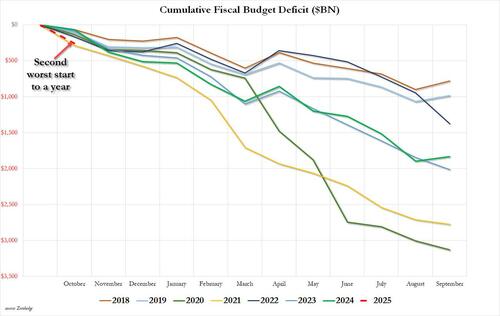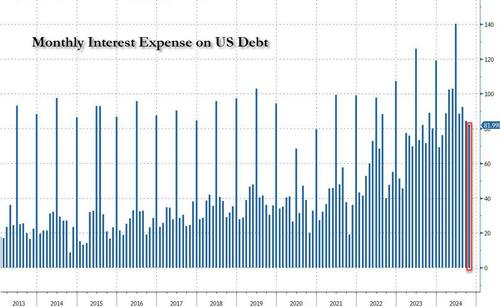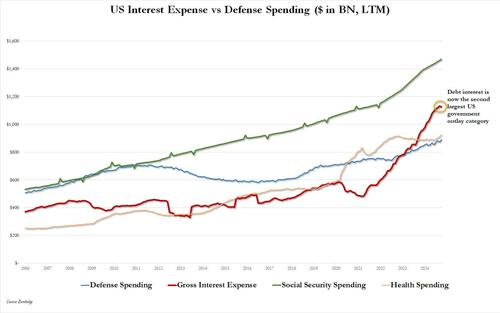Authored by Vince Bielski via RealClearEducation,
Maryland’s new education chief, Carey Wright, an old-school champion of rigorous standards, is pushing back against efforts in other states to boost test scores by essentially lowering their expectations of students.
States, including Oklahoma and Wisconsin, are making it easier for students to demonstrate on annual assessments that they are proficient in math and English after a decade of declining test scores nationwide. By redesigning the assessments and lowering the so-called “cut scores” that separate achievement levels such as basic, proficient, and advanced, several states have recently posted dramatic increases in proficiency, a key indicator of school quality.
Wright warns that lowering the bar on proficiency can create the public impression that schools are improving and students are learning more when, in fact, that’s not the case.
“You can make yourself look better to the public by lowering your cut scores,” Wright, the Maryland state superintendent of schools, told RealClearInvestigations in an interview. “But then you are not really measuring proficiency. My position is no, no, no. Parents and teachers need to know if their children are proficient or not.”
As most public schools continue to deal with the related crises of learning loss and chronic absenteeism years after COVID, Wright says now is the worst time to lower expectations of students, which can stifle the impetus to improve. In other moves to accommodate struggling students, districts and states have reduced graduation requirements and inflated grades with policies that ban failing marks. The best evidence comes from studies in Washington and North Carolina showing that grades have held steady at their pre-pandemic levels even though students are learning much less.
“With grades and assessments, the education system seems to be sleepwalking into a policy of ratcheting expectations down to better reflect what today’s students can do, rather than doubling efforts to help get students to where they need to be,” said Michael Petrilli, president of the Thomas B. Fordham Institute, which advocates for high academic standards.
Wright, who took over Maryland schools this summer, is refusing to backpedal on standards in a state that plunged from the top to the bottom in U.S. performance over the last decade. The superintendent says she aims to improve Maryland’s declining proficiency rates the hard way by making academic standards more rigorous in all content areas. As students learn more in class, the theory goes, they should become more proficient on state tests.
But a strategy that asks more of teachers and students is never an easy lift in districts that often resist top-down calls for change. Without direct control over school districts run by local boards, state superintendents like Wright must depend on the ability to inspire principals and teachers to follow their lead and meet inconvenient truths head-on.
Wright has done it before. As the state superintendent in Mississippi a decade ago, she collaborated closely with districts in lifting content standards and provided support to completely revamp literacy instruction in what was the worst-performing state in the union. Student proficiency soared without lowering cut scores. Educators called it the “Mississippi Miracle.”
“If you set the bar low, that’s all you are going to get,” Wright said. “But if you set the bar high for students, and support teachers and leaders, it’s doable.”
Lowering Cut Scores, Boosting Proficiency
Each state controls its own definition of proficiency and how students can achieve the all-important marker of academic success. They set their own content standards that detail what students need to know in each grade, write their own tests to determine if they are proficient, and devise their own cut scores.
The undertaking is more art than science. There is no accepted single definition of what makes a student proficient. States mostly aim for grade-level proficiency, or what the average student can do, based on their own content standards. A handful of states shoot higher, approaching a more rigorous definition of proficiency spelled out by the National Assessment of Educational Progress (NAEP), commonly known as the Nation’s Report Card.
By moving the bar on tests and cut scores, education officials have instantly raised or lowered proficiency rates. Over the years, some states have added enough rigor to allow only a third of students to show proficiency while others have reduced it to ensure that the vast majority perform well, Marianne Perie, who has helped more than a dozen states develop assessment methods, told the New York Board of Regents last year.
Today, states are lowering the bar and lifting proficiency rates. “Oklahoma just lowered their cut scores and Wisconsin is another one that ended up with less rigorous cut scores,” Perie told RCI. “If more kids are proficient this year compared with the previous years, it indicates that cut scores are less rigorous or that kids learned a lot more over the last year.”
High Standards Fall in Wisconsin
Wisconsin, like most states, has experienced a big drop in proficiency. In 2017, 44% of public school students were deemed proficient in English. That percentage fell in 2018 and 2019 and then plunged in the early years of the pandemic before recovering a bit to 39% in 2023.
This year, Wisconsin rolled out its new test and cut scores. State Superintendent Jill Underly was transparent about the changes, explaining in October that the redesign was meant to fix a problem created a decade ago when Wisconsin and other states aligned their cut scores to an “extremely high” level used by NAEP, reducing Wisconsin’s proficiency rate in the years that followed. Underly wrote that Wisconsin’s new grade-level cut scores better reflect the actual proficiency of students, making results easier for families to understand.
What families saw was a dramatic boost in English proficiency to 48% this year – a nine percentage-point gain over 2023 – due to assessment changes that had nothing to do with classroom learning.
To be sure, the Wisconsin Department of Public Instruction didn’t tout the 2024 results. It announced that they shouldn’t be compared to prior years since testing methods changed. Still, families who don’t follow the fine print of assessments may be left with the impression that Wisconsin schools are performing much better this year.
Paul Peterson, a prominent Harvard professor of education policy who has tracked changes to state proficiency levels, says politics seems to be a driver in the lowering of testing rigor. “Student performance is falling so I would imagine the pressure on states to rethink standards must be considerable,” Peterson said. “Officials want to show that they are spending the public’s dollar well, and that students are learning.”
No Notice in Oklahoma
In Oklahoma, a similar assessment revamp unfolded this summer but with a controversial twist: State leaders in Oklahoma didn’t inform school districts or families that they had lowered the bar before releasing the test results in August, according to reports in the local media.
When school districts saw the results, principals and teachers were in disbelief over the huge increase in performance. In fourth grade English, for instance, 47% of students reached proficiency – an extraordinary 23-percentage-point jump compared to 2023.
Later in August state Superintendent Ryan Walters, a conservative who has been under fire for insisting that public schools teach the Bible, admitted that the state changed its assessment regime without publicly announcing it. Republican state lawmakers issued a statement criticizing Walters for “putting a false narrative out there” about a jump in test scores. Oklahoma’s Department of Education didn’t respond to a request from RCI for comment.
“I believe in transparency and communication,” said Perie, the testing expert. “Oklahoma was the only state where it seemed like they were hiding the changes.”
New York Denies Lower Standards
As in Wisconsin and Oklahoma, New York’s retooled content standards, assessments, and scoring also produced higher proficiency rates.
A New York education official told RCI that the goal was to determine what should be expected of today’s students and how to evaluate their proficiency in various subjects using the new content standards. New York saw a dramatic 13-percentage-point increase in math proficiency and a small boost in English in 2023, the year the changes were implemented.
Officials in New York and Wisconsin are adamant that the updated assessments don’t amount to a lowering of academic standards even though proficiency rates jumped. The New York official added that while several factors impact student achievement from year to year, instruction is one of the most highly related attributes.
“It is incorrect and irresponsible to derive from this that the standards have been lowered,” the official said in an email.
Petrilli of the Fordham Institute calls such explanations from state officials double speak. “By definition these states are lowering standards for proficiency because it’s easier for students to meet the standard than it was before,” he said.
Wright’s ‘Mississippi Miracle’
Education experts say Wright’s tenure as the state superintendent in Mississippi offers a lesson to states struggling with low proficiency rates today: Even in the worst of times, Wright showed, states can raise their expectations of students and get results.
When Wright took over Mississippi schools in 2013, they were at the very bottom in performance nationally. A mere 21% of fourth graders were proficient in reading, according to NAEP. Educators in the South would say, “At least we are not as bad as Mississippi.”
The decade before the pandemic was a time of rising expectations in public education. With Wright in charge, Mississippi joined half of the states in raising the bar for fourth-grade reading proficiency between 2013 and 2019.
The lifting of expectations was relatively easy. It’s policy making. The tough part for state superintendents was implementing changes in schools to reach those higher goals. For the most part, the higher bars didn’t translate into higher levels of proficiency by 2017, according to research by Daniel Hamlin at the University of Oklahoma and Harvard’s Peterson.
There are only theories as to why: After the Great Recession of 2009, school funding declined. The Obama administration relaxed federal accountability measures put in place by President George W. Bush’s No Child Left Behind reform of 2002. The advent of smartphones became a major distraction for students.
Mississippi was a notable exception. Its fourth-grade reading proficiency jumped by 11 percentage points from 2013 to 2019, rising to a top 20 performer in the U.S., according to NAEP. In math, the increase was equally impressive.
Wright got results the old-fashioned way, with a tenacious focus on improving proficiency for all students, including those living in poverty, says Washington Cole, then her chief of staff and now a district superintendent in Mississippi. To get there, Wright rolled out a literacy program that was backed by decades of research and, crucially, provided teachers and administrators with extensive training in the model and sent coaches into the lowest-performing schools. “The professional development was a huge part of it,” Wright said.
Wright also toughened the district grading system that provided public accountability. When districts earned an “A” for performance, they were publicly celebrated by community members and lawmakers, adding to the incentives for other districts to improve. Over a decade, Wright’s team transformed Mississippi into an unlikely national K-12 success story.
“Dr. Wright set high expectations and her hard work and determination were very infectious with everyone. She was amazing,” Cole said. “I have no doubt that she will do the same thing in Maryland.”
Maryland Tries a Turnaround
Wright has her work cut out for her. After a decade of decline in Maryland, 48% of students are proficient in English and 24% in math.
In Baltimore City, where almost all students are black or Latino, the numbers are tragically low. Only 6% of middle and high schoolers are proficient in math. More than 40% of Baltimore City students were chronically absent last year, according to a district estimate, well above the national average. Students can’t learn if they don’t show up.
None of this seems to faze Wright, who assumed permanent leadership of Maryland’s schools in July. In returning to her native state, where she earned her doctorate in education and began her career as a teacher and administrator, Wright has wasted no time in setting a very ambitious goal.
“In the next three years we are expecting a 5-percentage point increase in proficiency each year in English and math,” she said.
To achieve that goal, Wright appointed a task force of teachers, leaders, experts, and parents to quickly recommend changes to the state’s accountability system, which she discovered painted a very rosy picture for the public. It was giving high marks to three-quarters of all schools despite their low proficiency scores. Wright wants the new system to provide school leaders with clearer measurements on a range of topics, such as the pace of student growth and graduation rates, so they can target their weak areas for improvement.
“Superintendents take a lot of pride in their ratings,” Wright said. “They want to be that district that gets recognized.”
Major changes are also coming to classrooms. Wright’s new early literacy policy, which won state board approval in October, details expectations for instruction based on the science of reading and teacher training in an attempt to lift test scores that have fallen to 41st in the country.
The biggest change in policy puts an end to social promotion. Districts with parental consent will be able to hold back third graders who don’t meet literacy standards rather than promote them to fourth grade, where they will continue to struggle to read, hampering their future performance. It’s the kind of bold change that Wright wasn’t hesitant to push despite opposition from some board members and families concerned about the impact on disadvantaged students.
It worked for Wright in Mississippi, producing a very large increase in reading performance by sixth grade, according to researchers.
“Putting a stake in the ground and saying we are not just going to move kids along if they haven’t learned to read by grade 3 is very powerful and much needed for our education system,” said Joan Dabrowski, the chief academic officer of Baltimore City Public Schools. “Dr. Wright is very clearly telling the districts they need to prioritize this policy and the state will be monitoring districts so there is a lot of accountability.”
Will the policy work? Dabrowski says it depends on the support teachers and principals receive from Wright to make the difficult changes over several years. “I like everything in the policy, but there are lots of points where implementation could go well or not go well,” she said.
Illinois Next to Lower Cut Scores
In June, Illinois made clear that it plans to boost proficiency too by following the approach of Wisconsin. Illinois Superintendent Tony Sanders said in a report that his state has one of the toughest definitions of proficiency in the nation. He said students who are on track for college could be mislabeled as not proficient, sending a wrong message to their families.
To fix this, Illinois is planning to adjust its assessment methods by 2025, which will likely boost the state’s proficiency rates.
If Wright fails in Maryland, would she consider following Illinois and other states in easing the rigor of assessments?
She scoffed at the idea.
“When you look over the last decade of dropping test scores, now is not the time to be lowering the bar,” she said. “If you don’t set high expectations, you’re never going to achieve the kinds of goals that you want to achieve. And in our business, it’s called student learning.”


















